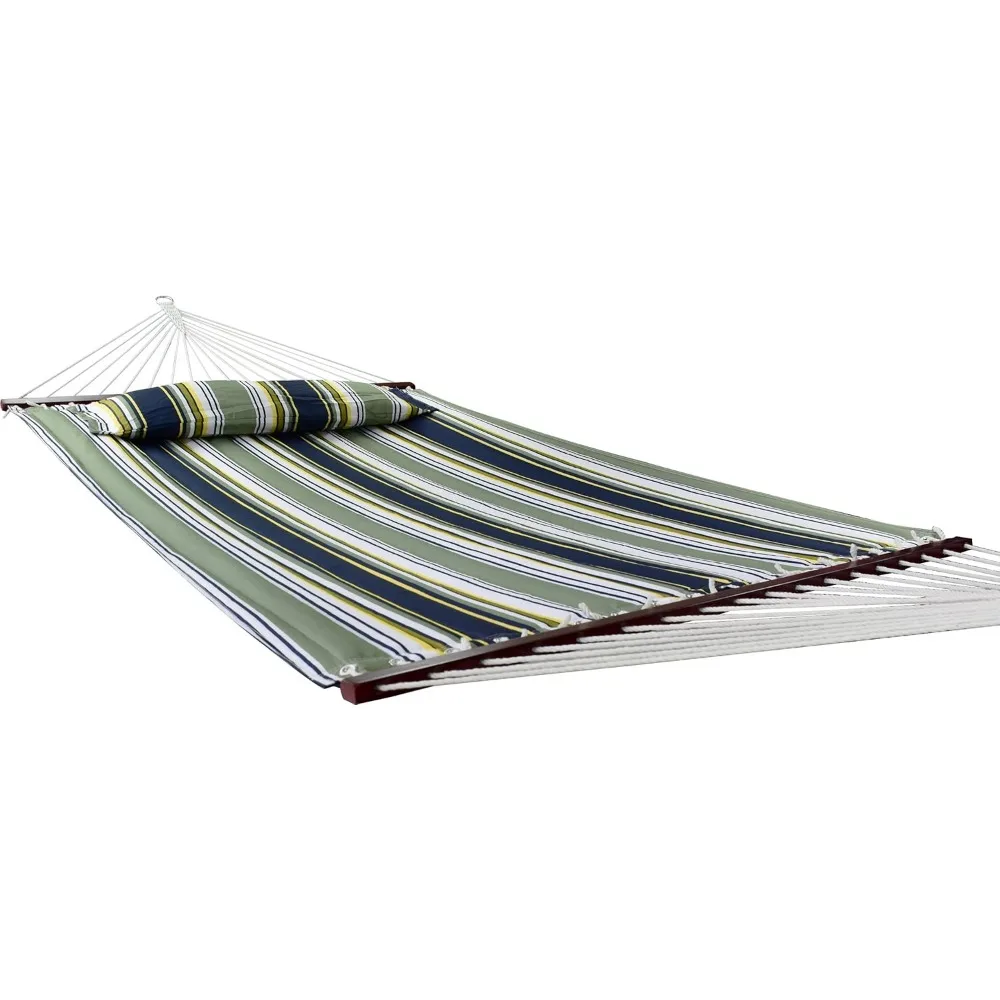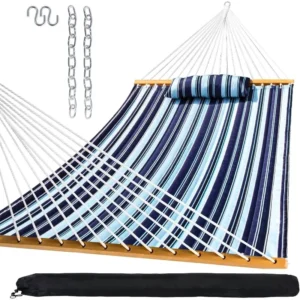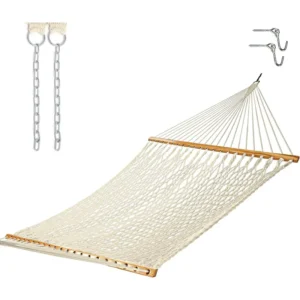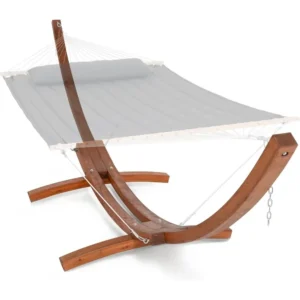Why Fabric Hammocks Are Perfect for Backyard Relaxation
Fabric hammocks represent the perfect blend of comfort and durability for outdoor relaxation. Unlike their rope counterparts, fabric hammocks offer a smooth, continuous surface that cradles your body while providing superior weight distribution. This makes them particularly well-suited for creating a backyard sanctuary where you can escape the stresses of daily life.
Transforming your outdoor space into a relaxation retreat begins with selecting the right hammock. A quality fabric hammock serves as both a functional piece for rest and a statement piece that enhances your garden aesthetic. The right choice can turn an ordinary backyard into an oasis of tranquility.
The benefits of hammock relaxation extend beyond simple comfort:
- Reduced stress levels through gentle rocking motion
- Improved sleep quality with zero pressure point support
- Enhanced outdoor enjoyment and connection with nature
- Versatile relaxation for reading, napping, or socializing
Understanding the differences between indoor and outdoor hammock placement helps you maximize your relaxation experience. While indoor hammocks provide year-round access, outdoor options like those in our fabric hammock sets collection allow you to bask in natural surroundings while enjoying fresh air and sunshine.
In this comprehensive guide, we’ll explore everything you need to know about selecting the perfect fabric hammock for your backyard oasis – from material choices to installation techniques – ensuring your investment brings years of outdoor enjoyment.
What Makes a Fabric Hammock “Best” for Backyard Use?
Determining what makes a fabric hammock truly “best” for backyard use requires understanding the unique challenges of outdoor environments. Unlike indoor hammocks or portable camping options, backyard hammocks must withstand weather variations while maintaining both comfort and aesthetic appeal over extended periods.
The perfect backyard hammock balances durability with luxury, creating an inviting retreat that withstands the elements. When evaluating options for your outdoor space, six essential qualities should guide your decision:
Weather Resistance & Durability: Outdoor hammocks face constant exposure to sun, rain, and humidity. Premium options resist fading, mildew growth, and fabric deterioration. Understanding whether it’s okay to leave hammocks outside helps you select materials that withstand your specific climate conditions.
Comfort & Fabric Feel: The tactile experience matters tremendously for relaxation. The best fabrics maintain softness against skin while providing adequate support through proper weight distribution and breathability.
Ease of Maintenance: Outdoor items inevitably collect dirt, pollen, and occasional spills. Look for fabrics that clean easily without special treatments and resist staining from environmental elements.
Visual Appeal: Your hammock becomes a focal point in your outdoor aesthetic. Consider how colors, patterns, and overall design complement your existing landscape and outdoor furniture.
Setup & Stability: Safety combines with convenience when hammocks install securely and remain stable during use. Quality anchoring systems and appropriate weight ratings prevent accidents and ensure peace of mind.
Value & Investment: Rather than focusing solely on initial price, evaluate long-term value through expected lifespan, warranty coverage, and construction quality that prevents frequent replacements.
These criteria provide the framework for evaluating the hammock options we’ll explore throughout this guide, helping you make an informed decision that matches your specific backyard needs.
Best Fabric Types for Backyard Hammocks: Detailed Comparison
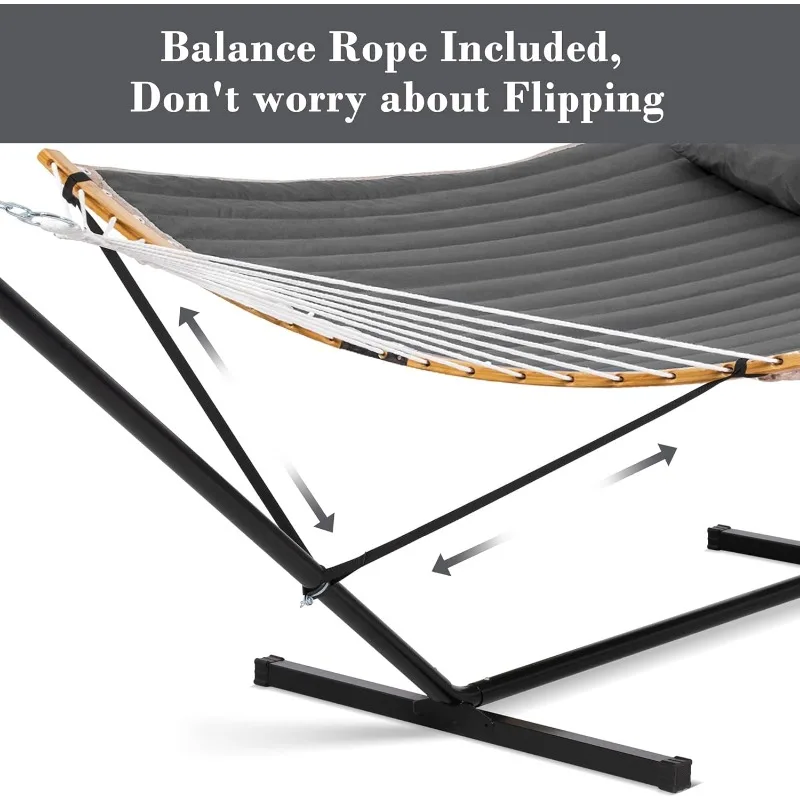
The fabric of your hammock fundamentally determines its performance in outdoor settings. Each material offers distinct advantages and limitations that directly impact your relaxation experience and the hammock’s longevity. Understanding these differences allows you to select the perfect match for your climate and usage patterns.
Cotton
Natural cotton offers unparalleled softness and breathability, creating a supremely comfortable relaxation experience. It conforms naturally to body contours and feels pleasant against bare skin. However, cotton’s vulnerability to weather presents significant challenges for permanent outdoor installation. Without proper protection, cotton hammocks absorb moisture, develop mildew, and deteriorate when exposed to UV rays. While incredibly comfortable, cotton requires diligent maintenance and storage during inclement weather.
Polyester
Synthetic polyester addresses many of cotton’s weaknesses while maintaining reasonable comfort. These hammocks resist water absorption, dry quickly after rain, and withstand UV exposure without rapid deterioration. Modern manufacturing techniques have improved polyester’s feel significantly, though it still lacks cotton’s natural softness. For practical backyard installation where hammocks might remain outside for extended periods, polyester offers excellent durability with minimal maintenance requirements.
Solution-Dyed Acrylics (Sunbrella)
Premium hammocks often feature solution-dyed acrylics like Sunbrella fabric, representing the gold standard for outdoor performance. These fabrics incorporate UV-resistant dyes throughout the material rather than merely on the surface, preventing fading even after years of sun exposure. They resist water, mildew, and staining while maintaining a surprisingly soft feel. Though commanding higher prices, these fabrics typically offer the longest lifespan, making them economical over time for permanent installations.
Nylon
Lightweight and quick-drying, nylon hammocks excel in portability but present limitations for permanent backyard setups. While highly resistant to moisture and mildew, nylon’s thinner construction can feel less substantial and typically offers reduced UV resistance compared to other synthetics. These hammocks work well for occasional use but may not provide the durability needed for constant outdoor exposure.
Fabric Blends
Many modern hammocks feature strategic blends combining natural and synthetic fibers to balance comfort with durability. Common combinations include cotton-polyester blends that improve weather resistance while maintaining softness. These represent a middle ground between pure cotton comfort and synthetic durability.
Understanding fabric hammock durability helps you make informed decisions when comparing options. This comparison table highlights how each fabric performs across key metrics for backyard use:
| Fabric Type | Weather Resistance | Durability | Comfort | Maintenance | Initial Cost | Long-term Value |
|---|---|---|---|---|---|---|
| Cotton | ★★☆☆☆ | ★★☆☆☆ | ★★★★★ | ★★☆☆☆ | ★★★☆☆ | ★★☆☆☆ |
| Polyester | ★★★★☆ | ★★★★☆ | ★★★☆☆ | ★★★★☆ | ★★★☆☆ | ★★★★☆ |
| Solution-Dyed Acrylic | ★★★★★ | ★★★★★ | ★★★★☆ | ★★★★★ | ★★☆☆☆ | ★★★★★ |
| Nylon | ★★★☆☆ | ★★★☆☆ | ★★★☆☆ | ★★★★☆ | ★★★★☆ | ★★★☆☆ |
| Fabric Blends | ★★★☆☆ | ★★★☆☆ | ★★★★☆ | ★★★☆☆ | ★★★★☆ | ★★★☆☆ |
Top 5 Fabric Hammocks for Backyard Luxury
After extensive testing and evaluation against our established criteria, these five fabric hammocks represent the pinnacle of backyard relaxation options. Each excels in specific areas while maintaining high overall quality standards.
1. The Sunbrella Quilted Double
This premium option features solution-dyed Sunbrella fabric with plush polyester filling quilted between layers for exceptional comfort. The reversible design offers two color options in one hammock, while spreader bars maintain a flat, accessible surface.
- Fabric: Solution-dyed Sunbrella acrylic
- Weight Capacity: 450 lbs
- Dimensions: 55” x 80” (lying area)
- Weather Features: Complete resistance to fading, water, and mildew
- Price Range: $$$
Pros:
– Exceptional 5-year color fastness even in direct sunlight
– Zero maintenance beyond occasional hosing down
– Supremely comfortable quilted surface
– Elegant appearance enhances landscape design
Cons:
– Premium price point
– Heavier than non-quilted options
– Requires more storage space when not in use
Ideal for: Households seeking the absolute best long-term investment for permanent backyard installation.
2. The Classic Cotton Double
This traditional design combines thick cotton construction with handcrafted details for maximum comfort. The gathered-end style creates a cocoon-like embrace without spreader bars.
- Fabric: 100% cotton canvas
- Weight Capacity: 400 lbs
- Dimensions: 60” x 84” (lying area)
- Weather Features: Natural breathability
- Price Range: $$
Pros:
– Unmatched softness and comfort against skin
– Elegant draping appearance when hung
– Excellent breathability for hot weather
– Traditional craftsmanship details
Cons:
– Requires storage during rainy periods
– Needs regular cleaning to prevent mildew
– Color fading occurs with extended sun exposure
Ideal for: Comfort-focused users who don’t mind bringing their hammock in during inclement weather.
3. The All-Weather Polyester Family Hammock
This extra-large design accommodates multiple users with reinforced stitching and durable construction. The weather-resistant polyester ensures minimal maintenance requirements.
- Fabric: High-density polyester with UV stabilizers
- Weight Capacity: 550 lbs
- Dimensions: 65” x 95” (lying area)
- Weather Features: Quick-drying, UV-resistant
- Price Range: $$
Pros:
– Exceptional capacity for couples or families
– Minimal color fading over multiple seasons
– Can withstand occasional rain showers
– Excellent value-to-durability ratio
Cons:
– Slightly rougher texture than natural fibers
– May require occasional retightening of suspension
– Limited color options
Ideal for: Families seeking a durable, low-maintenance option that accommodates multiple users.
4. The Luxury Spreader Bar Hammock
This elegant design combines weather-resistant performance with decorative appeal through hardwood spreader bars and an eye-catching pattern.
- Fabric: Olefin performance fabric
- Weight Capacity: 400 lbs
- Dimensions: 55” x 82” (lying area)
- Weather Features: Stain-resistant, quick-drying
- Price Range: $$$
Pros:
– Designer patterns enhance outdoor décor
– Superior stain resistance for outdoor entertaining
– Maintains tautness without significant stretching
– Hardwood spreader bars add stability and visual appeal
Cons:
– Less stable for restless sleepers
– Requires more precise installation
– Premium price point
Ideal for: Design-conscious homeowners who want their hammock to serve as a statement piece.
5. The Portable Weather-Resistant Double
This versatile option balances durability with portability, allowing for both permanent installation and occasional repositioning around your yard.
- Fabric: Textilene mesh with polyester reinforcement
- Weight Capacity: 450 lbs
- Dimensions: 58” x 78” (lying area)
- Weather Features: Fully weatherproof, mildew resistant
- Price Range: $$
Pros:
– Exceptional breathability prevents heat buildup
– Completely weatherproof for year-round outdoor use
– Lightweight design allows repositioning
– Includes storage bag for travel or winter storage
Cons:
– Mesh texture feels less luxurious than solid fabrics
– Limited color options
– Utilitarian appearance compared to decorative options
Ideal for: Practical users who value versatility and complete weather resistance over aesthetic considerations.
Our double two-person hammock sets offer additional options when you need spacious comfort for sharing your relaxation time.
Key Features to Consider When Selecting Your Backyard Hammock
Beyond fabric type, several key features significantly impact your hammock experience. Understanding these elements ensures your selection aligns perfectly with your specific relaxation needs and backyard environment.
Size Dimensions
Hammock size directly affects comfort, especially for taller individuals or couples sharing the space. Standard single hammocks typically measure 4-5 feet in width, while doubles range from 5-6 feet. Length varies from 7-9 feet for the lying surface. For comfortable two-person relaxation, select a hammock with at least 5.5 feet of width to prevent feeling cramped or unstable.
Weight Capacity
Safety requires selecting a hammock that substantially exceeds your actual weight requirements. Quality doubles typically support 400-500 pounds, while singles handle 250-350 pounds. For couples or family use, consider heavy-duty options with reinforced stitching at stress points. Always add a 50-100 pound safety buffer beyond your expected maximum load.
Spreader Bar Design
The decision between spreader bar and gathered end designs significantly impacts your experience. Spreader bars (horizontal wooden or metal rods at each end) create a flatter, more bed-like surface that’s easier to enter and exit. However, they reduce stability and increase the likelihood of tipping. Traditional gathered end hammocks (without spreader bars) create a deeper cocoon shape that’s more stable but can feel confining to some users.
Our spreader bar hammock sets collection offers various styles incorporating this popular design feature.
Suspension Systems
How your hammock attaches to supports affects both safety and adjustability. Quality options include:
- Rope attachments with multiple connection points for adjustability
- Chain systems offering precise height adjustment
- Hardware-based systems with S-hooks or carabiners for quick installation
- Integrated tree straps that prevent damage to bark
Weather Protection Features
Additional elements can extend your hammock’s outdoor lifespan:
- UV stabilizers preventing premature degradation
- Water-repellent treatments that maintain breathability
- Reinforced edges that resist fraying
- Removable pillows or pads for storage during harsh weather
Carefully evaluating these features alongside fabric choice ensures your selection provides the perfect balance of comfort, durability, and functionality for your specific backyard environment.
How to Properly Install a Fabric Hammock in Your Backyard
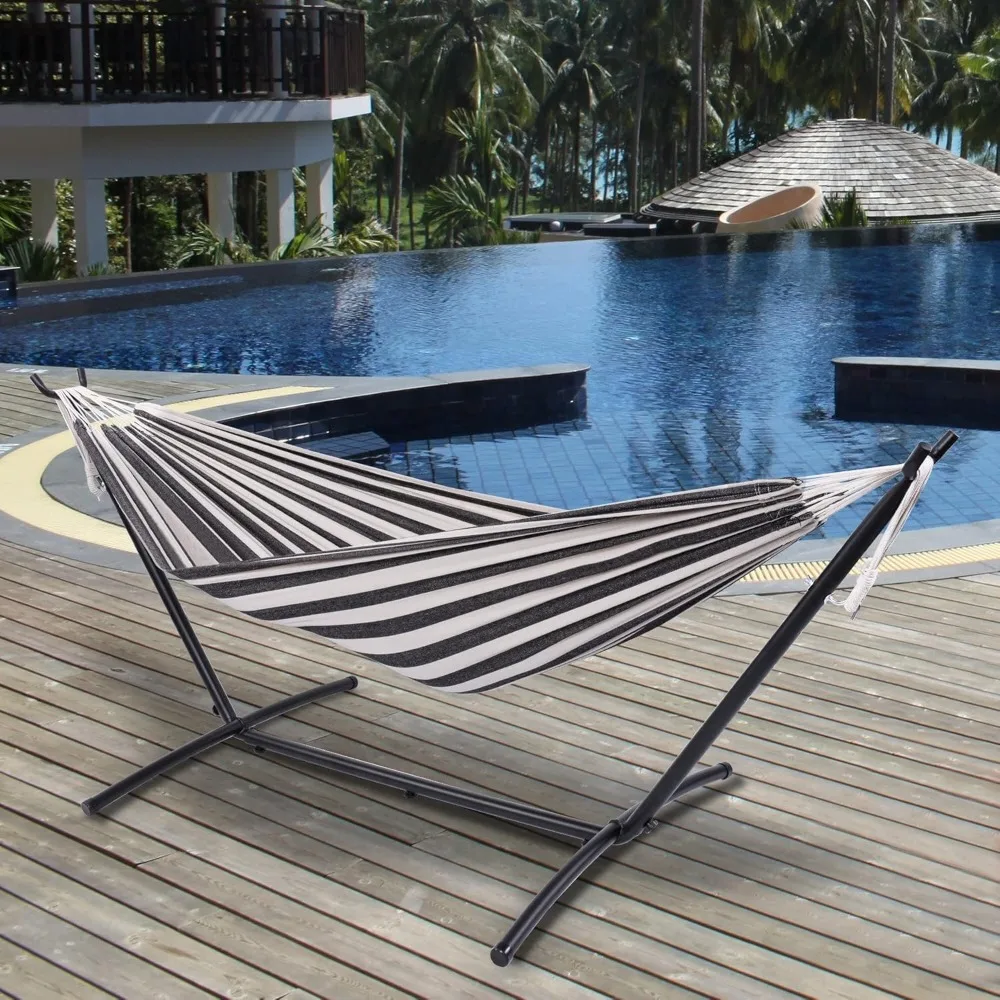
Proper installation ensures both safety and optimal comfort when enjoying your fabric hammock. Follow these guidelines to create a secure setup that maximizes relaxation potential.
Finding the Perfect Location
Select a spot that receives your desired mix of sun and shade throughout the day. Ensure the area remains free from sharp objects or abrasive surfaces that could damage your hammock fabric. Ideal anchor points should be sturdy trees, posts, or walls capable of supporting at least three times your hammock’s maximum weight capacity.
Determining Proper Spacing
The distance between anchor points critically affects your hammock’s hang. For standard fabric hammocks:
– Optimal distance: 2 feet longer than your hammock’s total length
– Minimum distance: Equal to hammock length (creates steeper angle)
– Maximum distance: 4 feet beyond hammock length (creates flatter hang)
Achieving the Ideal Hanging Height
For proper sag and comfort:
– Hang the center point 18-24 inches above ground when empty
– Allow for 30% sag in the middle when loaded
– Check that seated height keeps you 12-18 inches above ground
– Never hang higher than 3 feet at the lowest point to prevent injury
Secure Installation Methods
For trees:
1. Use wide tree straps (at least 1 inch wide) to prevent bark damage
2. Position straps at least 6 feet above ground level
3. Ensure straps can support 500+ pounds
4. Check that the tree diameter exceeds 12 inches
For posts/permanent structures:
1. Use galvanized eye-hooks rated for outdoor use
2. Select hardware rated for at least 500 pounds
3. Install into solid wood or concrete, never into hollow materials
4. Apply silicone sealant around permanent hardware to prevent water damage
Understanding proper hammock installation requirements and safety guidelines helps prevent accidents and ensures long-term enjoyment. Always perform regular safety checks, looking for frayed fabric, weakened connection points, or damaged hardware before each use.
Maintaining Your Fabric Hammock for Years of Enjoyment
Proper maintenance significantly extends your hammock’s lifespan while preserving its comfort and appearance. Different fabric types require specific care approaches to maintain their best qualities.
General Maintenance Guidelines
Regardless of fabric type, these practices help preserve your hammock:
– Brush off debris regularly before it becomes embedded
– Address spills immediately before they set in
– Store during severe weather events (high winds, hail, snow)
– Ensure hammock is completely dry before long-term storage
– Inspect hardware and connection points monthly
Fabric-Specific Care Instructions
Cotton Hammocks:
– Hand wash with mild soap and lukewarm water
– Avoid bleach or harsh detergents
– Air dry completely before rehanging
– Apply fabric protector spray seasonally
– Store indoors during extended rainy periods
Polyester/Synthetic Hammocks:
– Clean with garden hose and mild soap
– Brush gently to remove stubborn dirt
– Can remain outdoors in light rain
– Avoid petroleum-based cleaners that degrade fibers
– Check for sun damage annually
Solution-Dyed Acrylic (Sunbrella):
– Clean with diluted dish soap and soft brush
– Rinse thoroughly to prevent soap residue
– Can handle diluted bleach for mildew treatment (1:4 ratio)
– No need for additional waterproofing treatments
– Can remain outdoors year-round in moderate climates
Understanding how to select the perfect outdoor fabric hammock includes knowing how to care for your specific material type. With proper maintenance, quality fabric hammocks can provide 5-10 years of consistent enjoyment before needing replacement.
Can Fabric Hammocks Stay Outside Year-Round?
This common question depends largely on your specific hammock material and local climate conditions. While some fabrics withstand outdoor exposure better than others, all benefit from some level of protection against extreme elements.
Weather Tolerance By Fabric Type
– Solution-dyed acrylics (Sunbrella): Can remain outdoors in most conditions; remove during freezing weather or severe storms
– Polyester: Moderate outdoor durability; bring in during extended rainy periods and winter months
– Olefin: Excellent weather resistance; store during freezing temperatures
– Cotton: Limited outdoor durability; requires storage during rain and high humidity
– Nylon: Good rain resistance but poor UV protection; requires regular rotation to prevent sun damage
Climate Considerations
– Humid climates: Prioritize mildew resistance; avoid cotton for year-round installation
– Sunny regions: Select UV-stabilized fabrics; implement shade protection during peak hours
– Seasonal areas: Invest in proper winter storage solutions if temperatures drop below freezing
– Coastal environments: Choose salt-spray resistant materials like solution-dyed acrylics
Protective Measures
For extended outdoor placement:
– Install in partially shaded areas to reduce UV exposure
– Use removable weather covers during severe weather
– Position away from tree sap or bird nesting areas
– Implement seasonal rotation to distribute wear evenly
– Apply appropriate fabric protectants according to manufacturer guidelines
Finding the perfect hammock placement in your home garden involves balancing sun exposure, accessibility, and protection from environmental stressors. With appropriate material selection and protective measures, many fabric hammocks can remain outdoors for extended periods without significant deterioration.
What’s the Difference Between Single and Double Fabric Hammocks?
Understanding size distinctions helps you select the appropriate hammock for your relaxation needs. While the terms “single” and “double” seem straightforward, several nuanced differences beyond basic dimensions affect comfort and functionality.
Dimensional Comparison
| Feature | Single Hammock | Double Hammock |
|———|—————|—————|
| Width | 4-5 feet (48-60 inches) | 5-6.5 feet (60-78 inches) |
| Length | 7-9 feet | 7-10 feet |
| Weight Capacity | 250-350 lbs | 400-550 lbs |
| Typical Fabric Used | 1-2 yards | 2-3 yards |
Comfort Considerations
Single hammocks provide a snug cocoon effect that many users find comforting. The narrower width naturally centers the body and prevents rolling. Double hammocks offer more freedom of movement, allowing diagonal positioning that many find more ergonomic for extended lounging. For single users, doubles provide luxurious space but may feel less secure without proper positioning.
Practical Applications
Singles excel for:
– Limited space installations
– Lightweight portability
– Budget-conscious shoppers
– Users who prefer a secure, wrapped feeling
Doubles excel for:
– Sharing between two people
– Solo users who want maximum space
– Side sleepers needing diagonal positioning
– Creating a centerpiece relaxation zone
Our quilted fabric hammock sets come in both single and double options to accommodate different space requirements and user preferences.
Are Fabric Hammocks with Spreader Bars Better than Traditional Designs?
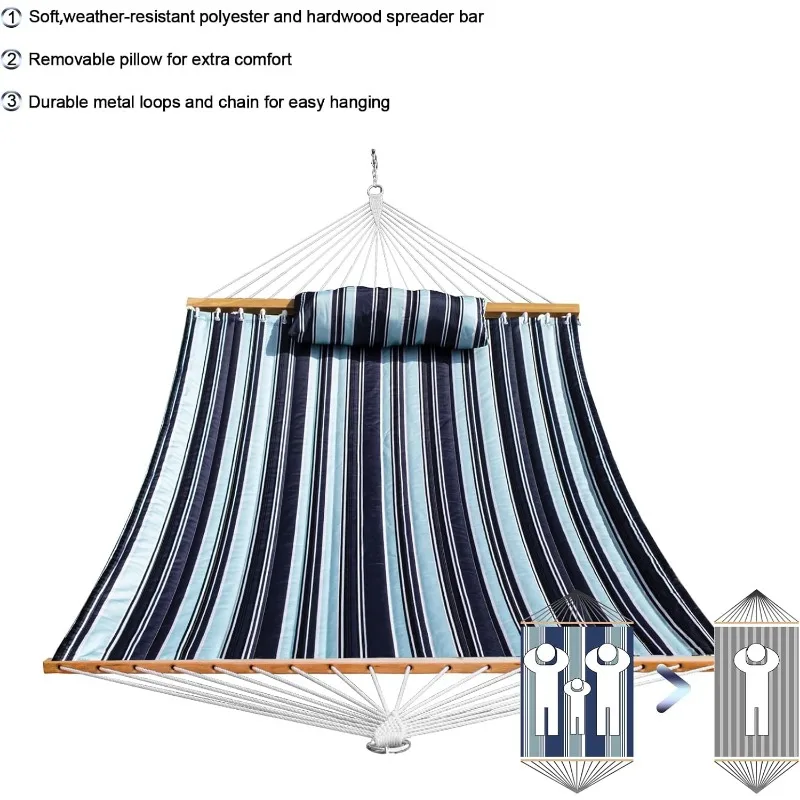
The debate between spreader bar and traditional gathered-end designs centers on the balance between accessibility and stability. Neither style is universally “better” – each offers distinct advantages depending on your priorities and usage patterns.
Spreader bar hammocks incorporate horizontal rods at each end that hold the fabric taut and flat. This creates a bed-like surface that’s easier to enter and exit, especially for those with mobility concerns. The flat profile also prevents the “cocoon effect” that some users find claustrophobic. Visually, these hammocks create a striking horizontal display in your landscape, serving as both functional relaxation spots and design elements.
Traditional gathered-end hammocks (without spreader bars) bundle fabric at attachment points, creating a deeper curve when occupied. This design naturally centers the body and prevents accidental tipping – a common issue with spreader bar models. The enveloping sensation provides exceptional security for napping and creates a more authentic tropical hammock experience. These hammocks also adapt better to different hanging distances.
For entry and exit ease, spreader bar models clearly win with their flat, accessible surface. However, this comes with significantly higher tipping risk, especially for users unfamiliar with proper weight distribution. Traditional designs require a specific entry technique but reward users with nearly impossible-to-tip stability once positioned.
The visual impact differs substantially between styles. Spreader bars create an open, inviting appearance that showcases decorative fabrics. Traditional designs display elegant draping when empty but conceal most fabric patterns when occupied. Consider which aesthetic better complements your outdoor design vision.
A-Frame Stand Hammock Sets, Swinging Hammock Chair Sets
$154.62 Select options This product has multiple variants. The options may be chosen on the product pageClassic Wooden Stand Hammock Sets, Heavy Duty Hammock Sets
$1,061.68 Select options This product has multiple variants. The options may be chosen on the product pageHammock Sets with Canopy, Heavy Duty Hammock Sets
$286.31 Select options This product has multiple variants. The options may be chosen on the product pageDouble / Two Person Hammock Sets, Rope Hammock Sets
Double Traditional Cotton Rope Hammock with Extension Chains – 450 lbs Capacity for Backyard & Patio$292.98 Select options This product has multiple variants. The options may be chosen on the product pageHeavy Duty Hammock Sets, Wooden Arc Stand Hammock Sets
$878.66 Select options This product has multiple variants. The options may be chosen on the product page
Storage requirements also differ meaningfully. Traditional hammocks roll or fold into compact bundles, while spreader bar models remain rigid and require significantly more storage space during off-seasons or severe weather.
Your selection should prioritize your most important use case. Choose spreader bars for casual, occasional use with emphasis on easy access; select traditional designs for secure napping and situations where stability matters most.
Frequently Asked Questions About Backyard Fabric Hammocks
How much weight can fabric hammocks typically hold?
Most quality fabric hammocks support between 250-550 pounds, with singles typically rated for 250-350 pounds and doubles for 400-550 pounds. Always check the manufacturer’s specific weight rating and select a hammock with capacity at least 50-100 pounds beyond your anticipated maximum load. Our heavy-duty hammock sets offer enhanced capacity for multi-person use or users requiring additional support.
How do I prevent my fabric hammock from flipping?
Preventing flips involves proper entry technique and weight distribution. Always sit in the center before swinging your legs up, keeping your weight centered along the middle axis. For spreader bar hammocks, position yourself diagonally for maximum stability. Traditional gathered-end designs naturally resist flipping but require centering your body weight. Hanging height also affects stability – lower installations typically provide greater stability than higher ones.
What’s the best distance between hanging points?
Optimal distance equals your hammock’s total length plus 1-2 feet. This allows proper sag (approximately 30% when loaded) while maintaining appropriate tension. Hanging points too close create excessive droop and potential ground contact; points too far apart create uncomfortable tension and reduce weight capacity. Adjustable suspension systems allow fine-tuning to achieve the perfect balance between support and comfort.
Are fabric hammocks safe for children?
With proper supervision and installation, fabric hammocks can be safe for children. Key safety measures include: limiting height to minimize fall impact, selecting hammocks with stable designs (traditional over spreader bar for young children), establishing clear usage rules, and regular inspection for wear or damage. Never leave very young children unattended in hammocks, and avoid using hammocks as play equipment or for rough activities.
How do I stop my hammock from stretching over time?
Natural fiber hammocks (especially cotton) naturally stretch with use. Prevent excessive stretching by: avoiding exceeding weight capacity, implementing adjustable suspension systems that allow retensioning, storing properly when not in use (particularly avoiding damp storage), and considering synthetic fabrics like polyester that maintain dimensional stability better than natural fibers. Some initial stretching is normal and should be accommodated in your initial installation height.
Creating Your Perfect Backyard Relaxation Space with a Quality Fabric Hammock
Selecting the ideal fabric hammock transforms your outdoor space from ordinary to extraordinary. This decision combines practical considerations with personal preferences to create your ultimate relaxation experience.
For those prioritizing longevity and minimal maintenance, solution-dyed acrylic fabrics like Sunbrella represent the premium choice. These materials withstand years of sun exposure without fading and resist mildew even in humid environments. For the purist seeking traditional comfort, cotton offers unmatched softness but requires more diligent care and seasonal protection.
Remember that your hammock becomes both a functional retreat and a visual statement in your landscape. The style you select—whether spreader bar for accessibility or traditional for stability—should complement your existing outdoor aesthetic while meeting your practical needs.
Installation location significantly impacts your enjoyment. The perfect spot balances sun and shade throughout the day while providing the right distance between secure anchor points. Consider seasonal changes in foliage and sun angle when positioning your outdoor retreat.
Complete hammock systems with dedicated stands offer maximum flexibility for placement and repositioning throughout the season. Our hammocks and stands collection provides comprehensive solutions that eliminate the need for permanent installation.
Ultimately, the best fabric hammock transforms ordinary moments into extraordinary experiences—afternoon reading becomes a luxurious escape, evening relaxation becomes a connection with nature, and weekend naps become rejuvenating retreats. With the knowledge gained from this guide, you’re equipped to select the perfect fabric hammock that will serve as your backyard oasis for years to come.

